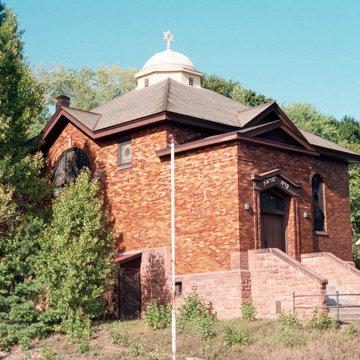Temple Jacob, originally Orthodox, but by 1913 a Conservative congregation, serves a small Jewish population in this charming but eccentric building sited on a sloping site below the residential area and on the major highway (U.S. 41) into Hancock from the northeast. A low-pitched raking cornice and zipper brickwork adorn the entrance of the copper-domed building. Above the basement social hall/classroom is a sanctuary; the latter has a balcony, originally the women's gallery, now little used. There is a Georgian-style ark crowned by lions supporting the tablets of the law. Behind the balcony is a tripartite stained glass window whose pale hues are repeated in the memorial windows around the room. The central panel in each features depictions of the Torah, ram's horn, dove bearing the olive branch of peace, burning bush, hands in an attitude of blessing, eternal light, and menorah. Archie Verville was the builder. Jewish families contributed to the growth of the Copper Country region. Jews came as entrepreneurs, often beginning as peddlers, and eventually opened shops. More than one hundred Jewish families lived in the Copper Country in 1912 when Temple Jacob opened its doors.
You are here
Temple Jacob
If SAH Archipedia has been useful to you, please consider supporting it.
SAH Archipedia tells the story of the United States through its buildings, landscapes, and cities. This freely available resource empowers the public with authoritative knowledge that deepens their understanding and appreciation of the built environment. But the Society of Architectural Historians, which created SAH Archipedia with University of Virginia Press, needs your support to maintain the high-caliber research, writing, photography, cartography, editing, design, and programming that make SAH Archipedia a trusted online resource available to all who value the history of place, heritage tourism, and learning.









